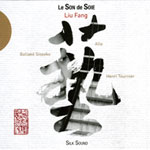 Ever since Liu Fang
left China for western climes she has opened up her classical pipa repertory
to other traditions. In Berlin her exchange with Syrian ‘oudist Farhan
Sabbagh resulted in Fang’s second release “Arabic and Chinese
music”. One critic wrote the following: “It is satisfying to hear
a group of instruments together, the way they relate, take turns, complement
each other. These are master musicians at work, indeed." Similar words
can be uttered over “Le Son de Soie”, a delicately embroidered
album that reveals a remarkable cogency between instruments worlds apart.
The West African kora of Ballaké Sissoko, the ‘oud played by
Alla of Algeria, and Henry Tournier’s bansuri flute, are in perfect
symbiosis with Fang’s pipa and guzheng.
Ever since Liu Fang
left China for western climes she has opened up her classical pipa repertory
to other traditions. In Berlin her exchange with Syrian ‘oudist Farhan
Sabbagh resulted in Fang’s second release “Arabic and Chinese
music”. One critic wrote the following: “It is satisfying to hear
a group of instruments together, the way they relate, take turns, complement
each other. These are master musicians at work, indeed." Similar words
can be uttered over “Le Son de Soie”, a delicately embroidered
album that reveals a remarkable cogency between instruments worlds apart.
The West African kora of Ballaké Sissoko, the ‘oud played by
Alla of Algeria, and Henry Tournier’s bansuri flute, are in perfect
symbiosis with Fang’s pipa and guzheng.
“I sensed keenly (sic.) her awakening to other forms of music,” explains Tournier in the elaborate sleeve notes, “During our improvisation sessions it became clear that it was the bansuri flute…which pleased her most and could respond best to her own musicality.” The osmosis does indeed appear complete in “Light wind in a cloud of falling snow-flakes,” yet it would be a disservice to the other virtuosic musicians on the album to claim they have come out second-best.
Mali’s Sissoko, in particular, complements Fang’s refined strumming of the pipa, this lute with some 2,000 years of history behind it. In the appropriately named “Première rencontre”, his kora gels with her pipa so gracefully that one wonders if they do not share a common heritage down the millenia. The plectra on Fang’s fingertips alternate between power and delicacy throughout the song, as she displays a technique rarely surpassed elsewhere. It echoes the words of a ninth century sage, quoted in the sleeve notes by Caroline Bourgine: “The stronger strings resonate like a sudden shower of rain, the finer ones like a suppressed sigh.”
Fang proves to
be equally adept on the guzheng, this plucked, half-tube zither with 21 strings.
The emotion she invests in this instrument of Persian origin transpires in each
note: “As she plays her zither, attacking and biting into the strings
with her right hand, she consciously replicates the actions and body movements
of a fish or bird,” Bourgine notes. This proximity with nature and its
animals underscores the spirit of this tranquil and flowing album. Improvisations
and spontaneity between the four master musicians never supersede a harmony
that seems engraved in the marbles of time. This is a CD to meditate over, and
with.
Daniel Brown, mondomix.com, May 2006

 CD
on-line order
CD
on-line order